Sverre Fehn Exhibition, Finland, 2009, Building, Project, News, Design
Sverre Fehn Architecture Exhibition, Finland
Museum of Finnish Architecture – 2009 Programme, Finland, Europe
22 Sep 2009
Sverre Fehn Exhibition
NEW EXHIBITIONS AT THE MUSEUM OF FINNISH ARCHITECTURE
23 Sep – 29 Nov 2009
ARCHITECT SVERRE FEHN : INTUITION – REFLECTION – CONSTRUCTION
Large hall
The work of Norway’s most prominent architect is exhibited in 18 built and unbuilt projects. Sverre Fehn is known especially for his museum and exhibition buildings and private houses. His poetic yet at the same time powerful architecture is represented by e.g. the Nordic Pavilion at the Venice Biennale (1962), Hedmark Museum (Hamar 1969/2005), his earliest private house Villa Schreiner (Oslo 1963), and Villa Busk (Bamble 1990) from his later career.
Producer: Norwegian National Museum of Art, Architecture and Design
Portrait of Sverre Fehn
(1924–2009)
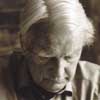
photo : Stina Glømmi
Museum of Finnish Architecture
Kasarmikatu 24, 00130 Helsinki
tel. (358 9) 8567 5111
Sverre Fehn Exhibition
Sverre Fehn (1924–2009) is the most remarkable architect of Norway and one of the great names of Nordic architecture. He is known above all for his museum and exhibition spaces and private houses. Fehn’s architectural idiom is modern but connects with the landscape and observes history. His poetic yet at the same time powerful architecture is based on structure, which to him is a medium of aesthetic expression.
I operate fairly rationally. The site means much to me, the house’s relationship to the landscape. In the reality that is Norway; standing there on the ground one hasn’t much else to realize one’s thoughts in relation to other than nature The intellectual world meets the landscape, and in the ensuing duel beauty is born. One mustn’t be sentimental on this point; one mustn’t begin to make a mess of the landscape. The more precise you can be, the more ruthlessly you can work out this meeting, the more powerful the accentuation of nature becomes, and the more intensely your architectural narrative comes into view. (SF, Scala 23/1990)
In the early phase of Fehn’s career, his older Norwegian colleague Arne Korsmo was a figure very important to him. Also crucial to his later development were his stay in Morocco in 1952–53 and subsequent work in the office of the prominent French architect Jean Prouvé in Paris.
The Norwegian Pavilion in the Brussels World Fair in 1958 brought international fame to the young architect. Interesting in the Finnish aspect is another well-known exhibition space, the joint Nordic Pavilion of Finland, Norway and Sweden built for the Venice Biennale in 1962. It allows trees to grow through the building, and its high roof structure filters light so it assumes a northern softness. Though these two important buildings are in different parts of Europe, most of Fehn’s works are in Norway.
Ivar Aasen Centre, Ørsta
2000
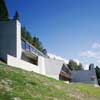
photo : Jiri Havran
The museums designed by Fehn are situated in old structures as well as new buildings. The Hedmark Museum (Hamar 1969), for instance, is fitted in the ruins of an ancient bishop’s fortress. Fehn’s last work, Norway’s National Museum – Architecture (Oslo 2008) comprises restored buildings and a pavilion-like extension. His new museum buildings include the Norwegian Glacier Museum (Fjærland 1991/07), located between mountains at the foot of Europe’s largest glacier.
A museum is a dance around dead things where the object and its relation to human movement is all important, quite the opposite of architecture where humans play the lead role and objects are secondary. (SF, exhibition book)
Fehn’s private houses are intimate as well as imposing. Many clients were his friends, and besides varying landscape conditions, his close relationship with different families has produced individual homes. There are some recurring features, too. Especially in the houses of the 1960s kitchens and bathrooms often form a central core, fireplace areas are on the edge, and the other rooms are organised depending on these. An example of such arrangement is Villa Schreiner (Oslo 1963). Fehn’s later house design is represented by Villa Busk (Bamble 1990), which is composed of a longitudinal main volume of concrete and a separate wooden tower.
When the house was finished, and the dramatic confrontation between nature and architecture completed, the line cutting both vertically and horizontally in the shifting hardness of the landscape, I had a feeling of it being a dream about a journey I still had not made. (SF, exhibition book)
Villa Busk, Bamble, Norway
1990
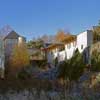
photo : Jiri Havran
Fehn became also known as an exhibition designer and participated with success in several architectural competitions. Many of his most innovative designs are winning competition entries, but unfortunately only few of them have been built. In addition to his design work, Fehn taught at the Oslo School of Architecture and Design in 1975–95.
Sverre Fehn was awarded the world’s highest architectural recognition, the Pritzker Prize, in 1997. He was honorary member of the Finnish Association of Architects SAFA from 1992. His work has been previously shown in Finland in 1992 in the Five Masters of the North exhibition at the Museum of Finnish Architecture.
The exhibition has been produced by the Norwegian National Museum of Art, Architecture and Design and curated by Eva Madshus. Sverre Fehn himself has selected the works on display. The exhibition has been previously shown in Oslo in spring 2008, Venice in autumn 2008 and Stockholm in early 2009.
The book published in connection with the exhibition,
ARCHITECT SVERRE FEHN. INTUITION – REFLECTION – CONSTRUCTION, is available at the museum bookshop.
The presentation has been supported by Embassy of Norway in Finland and Kulturfonden för Finland och Norge
The Nordic Pavilion, Venice, Italy
1962
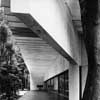
photo : Ferruzzi
On display:
Norwegian Pavilion, World Exhibition, Brussels, Belgium 1958, Competition, 1st prize, demolished
Nordic Pavilion, Biennale in Venice, Italy 1962, Competition, 1st prize
Mining Museum, Røros, Norway 1979, not built
Information Centre at the Viking Graves, Borre, Norway 1993, Competition, not built
Rock Carving Museum, Borge, Norway 1993, not built
Villa Schreiner, Oslo, Norway 1963
Villa Norrköping, Sweden 1964
Villa Busk, Bamle, Norway 1990
Extension to The Royal Theatre, Copenhagen, Denmark 1996, Competition, 1st prize, not built
Hedmark Museum at Domkirkeodden, Hamar, Norway 1969, 2005
Wasa Ship Museum, Stockholm, Sweden 1982, Competition, not built
Aukrust Centre, Alvdal, Norway 1996, Competition
Ivar Aasen Centre, Ørsta, Norway 2000
Norwegian Glacier Museum, Fjærland, Norway 1991, 2007
Verdens Ende Art Gallery, Tjøme, Norway 1988, not built
Chapel in Olavsundet, Ny-Hellesund, Norway 1999, project
The Gyldendal House, Oslo, Norway 2007
The National Museum – Architecture, Oslo, Norway 2008
Some argue that Fehn’s architecture is not based on a theory. He has not documented it in a written form, but his working method has a clear theoretical, abstract approach to the projects. It is individual, based on relationship between his various architecturally charged stories and their transformation towards a construction that releases their spatial identity. Per Olaf Fjeld in the exhibition book Architect Sverre Fehn. Intuition – Reflection – Construction
Location: Finland
New Finnish Architecture
Contemporary Architecture in Finland
Finnish Architecture Design – chronological list
New Finnish Buildings – Selection
Turku City Library
JKMM
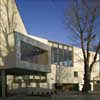
picture : Arno de la Chapelle
Turku City Library
Viikki Church, Helsinki
JKMM
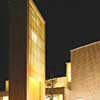
photo : Arno de la Chapelle
Viikki Church
Museum of Finnish Architecture Exhibition 2009
Decades of Finnish Architecture Exhibition 2009
Comments / photos for the Sverre Fehn Museum of Finnish Architecture Exhibition page welcome
Website : www.mfa.fi
